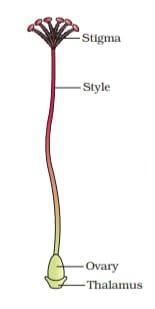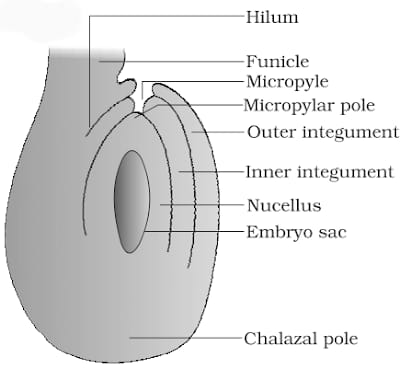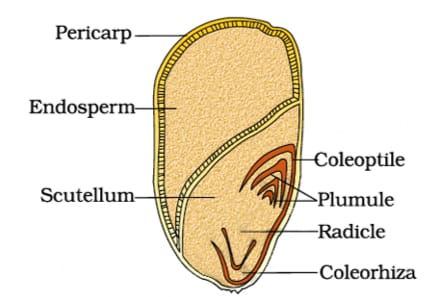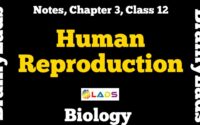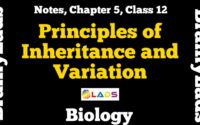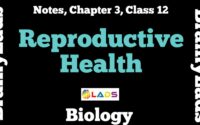Sexual Reproduction in Flowering Plants Class 12 | Chapter 2 | Biology |
Table of Contents
Sexual Reproduction in Flowering Plants Class 12 | Chapter 2 | Biology |
Flower – A Fascinating organ of Angiosperms
It is a condense modified shoot.
Sepal, Petal, Carpel, Stamen are modified leaves.
Thalamus – Swollen end of the tip that contain all the floral structure.
Anthesis – The period or process in which a bud become flower.
- Due to change in hormonal level and a different chemical signal a shoot get converted into reproduction apex.
Floriculture
Culturing of plant for flower is known as Floriculture.
Reproduction
It is a biological process of producing offspring of its own type.
Flower is a seat of sexual reproduction in angiosperms.
The process of development of new organisms through the formation and fusion of male and female gamates is called sexual reproduction or AMPHIMIXIS.
Male Reproductive Structure
A stamen (microsporophyll) is the male sex organ of flower. It has three parts : Anther , filament and connective.
The fertile part of a stamen is called Anther (also called male sporophyll).
In a typical Angiosperm, Anther is bilobed , dithecious and tetrasporoginate.
During the development , it is surrounded by a unilayer single protective covering known as Epidermis , that store primitive cell known as Aracheoporial cell.
Aracheoporial cell undergo periclinal division and form two cell.Outer is known as PARIETAL and inner cell is known as SPOROGENOUS.
Structure of Microsporangium
Parietal cell undergo repeated periclinal and anticlinal division and form Endothecium , 2 – 4 middle layers and Tapetum.
Sporogenous cell or inner side undergo repeated mitotic division and form Microspore Mother cell or Pollen Mother cell.
The wall of each pollen sac below epidermis , has a single layer of larger cells called Endothecium.
Endothecium – Helps in dehiscence of anther , followed by 2-4 middle layers.
Tapteum is the innermost layer. Thus a sporangium has wall of 4 – 5 layers . Cells of wal layers are diploid.
Thus in all , 4 types of wall layers (epidermis, endothecium, middle layers and tapetum) are found around the microsporangium (pollen sac).
Tapetum encloses sporogenous diploid cell which on division form pollen mother cells.
Tapetum is of two types –
- Amoeboid – It is of Amoeba shape and get diffuse within the sporogenous tissue and get fuse to form plasmodium structure.
It provide nutrition to the developing microspore.
- Secretory – It secret the specific molecule to perform the different function.
- It secret Callase enzyme to degrade Callose and liberate microspore from microspore tetrad.
- It secret ubiscch granule that is filled with sporopollin and form outer most protective covering of pollen grain i.e. EXINE.
- It secret specific glycoprotein on exine that help in pollen pistil interaction.
- It forms Pollen kit.
Tapetum cell is binucleate or multinucleate because just to perform different function it amplify its gene and it occur due to endomitosis.
Microsporogenesis
The process of formation of Microspore from microspore mother cell (MMC).
MMC undergo meosis and give rise to the Microspore tetrad.
- In 60 percent Angiosperm , 2 cell pollen grain get pollinated and after landing on the stigma, generative undergo mitotic division and give rise to the two male gamate.
- In remaining 40 percent Angiosperm , before pollination , generative cell undergo mitotic division and give rise to the 2 male gamate and 3 cell pollen grain pollinated.
Germinative pollen grain is the mature male gametophyte.
Structure of Male gametophyte –
Sporoderm – Dermis of the spore is known as Sporoderm.
Exine – Outermost protective covering made up of sporopollenin.
It is the toughest molecule that cannot be degrade by any enzyme , temperature , acid or base.
Due to the presence of exine , fossils of pollen grain found.
- Tectum decide the shape of the pollen grain and it help in identification of species , genus , family to which it belong.
Intine – The innermost continuous layer made up of pectin and cellulose.
Germ pore – The place on the pollen grain where exine is absent or thin.
It is the place from where pollen tube get originated.
Generative Cell – Small cell that float within the cytoplasm of the vegetative cell and give rise to the male gamate.
Vegetative cell – Large cell that give rise to the polen tube.
Difference between Generative and vegetative cell.
| Generative cell | Vegetative cell |
| Small in size. | Large in size. |
| Give rise to the male gamate. | Give rise to the pollen tube. |
| Have spindle nucleus. | Irregular nucleus. |
| Vacuole is not present. | Vacuole present. |
| Do not store food and have limited cytoplasm. | Stores food and have abundant cytoplasm. |
Viability of pollen grain :-
The time period for which pollen grain retain its ability to get germinate.
- It depend upon amount of food store and environmental factor like temperature and humidity.
- In bud pollinated plant , the viability of the pollen grain is very small.
For example – Wheat and Rice, they have only 30 minutes viability.
In few plant, viability may varies from days, months and years.
Pollen Bank – The place where pollen grain can store by using the technique ‘Cryopreservation’.
In cryopreservation, pollen grain are stored at – 196 degree in liquid Niitrogen (N2).
Advantage of Pollen grain :-
Pollen grain has store form of food. So, it have a nutritive value.
Atheletes mainly use pollen tablet or syrup to increase their efficiency.
Disdvantage of Pollen grain :-
Pollen grain are of micrspcopic size. So they mainly get inhale and cause respiratory problem like Bronchitis, Asthma or allergy.
Parthenium crop that come in India during the import of wheat mainly cause allergetic problem.
Female Reproductive Structure
Gynocium is the female reproductive structure and carpel or pistil is theb single unit of Gynocium.
It may consis of a single pistil i.e. Monocarpellary or may have more than one pistils i.e. Multicarpellary.
Multicarpellary is of two types : –
| Syncarpous | Apocarpus |
| It forms when more than one pistil get fused together. | It consist of free pistils . |
| Forms a single fruit. | It forms aggregate of fruits. |
| For ex – Papaver | For ex – Michelia |
Structure of Pistil
Each pistil has three parts – Stigma, Style and Ovary.
Stigma –
The receptical of pistil that received in pollen grain during pollination.
It involve in pollen pistil interaction and recognise whether pollen is of same species or not.
Style –
The stalk like structure that present in between stigma and ovary.
Ovary –
The last swallon part of the style is known as ovary.
It have ovules.
After the fertilisation, ovary get ripen and give rise to the fruit.
Inside the ovary is the ovarian cavity (locule).
The placenta is located inside the ovarian cavity.
Ovule –
It is the integument female gametophyte in which female gamate get form.
After the fertilisation, ovule give rise to seed.
- Arising from the Placenta are the megasporangia, commonly called ovules. The number of ovules in an ovary may be one (Wheat, paddy, mango) to many (papaya, water melon, orchids).
Structure of typical Angiosperm ovule
Nucellus – The Parenchymatous cell that store the food and provide nutrition to the developing Megaspore.
Nucellus is the site of development of female gametophyte.
Funicle – The stalk like structure that attach the ovule to the placenta.
Hilum – The point of attachment of funicle on the ovule.
Integument – Outer hard protective covering of ovule.
It is bilayer structure and outer layer is known as outer integument and inner layer is known as inner integument.
Micropyle – The end of the ovule where integument is absent.
Chalazal – The end opposite to the Micropyle in the ovule from where integument get originated.
Monosporic Development – A single functional megaspore give rise to the female gametophyte i.e. 7 celled 8 nucleated structure.
Antipodal cell –
The 3 cell that present toward the chalazal end.
They get degenerated during the fertilization.
Central cell –
The large cell present in the centre of the embryo sac and that contain 2 Haploid nucleus.
It get fuse with one of the male gamate and give rise to the triploid endosperm.
Egg Apparatus –
Group of 3 cell that present toward the micropyle end.
- It contain two synergid and one egg cell.
- In the cytoplasm, on the synergid cell there is a formation of finger like projection known as Filiform apparatus that help in catching of Male gamate from the pollen tube .
- Egg cell get fuse with Male gamate and give rise to the zygote during the fertilization.
Megasporogenesis
Development of Ovule
Pollination
Transfer of pollen grain from anther to the stigma of the pistil is known as Pollinatiom.
Autogamy/ Self Pollination
Transfer of pollen grain from anther to the stigma of the pistil within the same flower.
Condition for the self pollination –
- Flower must be bisexual .
- Both anther and pistil are in close Proximary.
- Required Synchrony in pollen release and stigma receptivity.
Types of self pollination:-
Cleistogamy – Takes place in close flower.
For example – Pea, Viola, Oxalis etc.
Bud pollination – Takes place before the opening of bud.
For example – Wheat and Rice.
Chasmogamy – Takes place within open bisexual flower.
Advantages of Self Pollination
- Maintain the parental character.
- Pollination takes place in the absence of pollinating agent.
- Pure line can be created.
- Superior plant of the variety can be created.
- Have seed assurance.
Disadvantages of Self Pollination
- Does not lead to variation.
- Inbreeding depression – Repeated self pollination lead to accumulation of recessive gene. It lead to decrease in fertility and productivity.
Cross Pollination
Geintogamy – Transfer of Pollen grain from anther to the stigma of the pistil present on the different flower but on the same plant.
- It is genetically self pollination and ecologically cross pollination.
Xenogamy – Transfer of pollen grain from anther to stigma of the pistil present on the different flower and on different plant.
- It is true cross pollination.
Advantages of Cross Pollination
- Lead to variation and help in evolution.
- Overcome inbreeding depression.
- Introduce new character within plant.
Disadvantages of Cross Pollination
- Does not maintain the parental character.
- Does not takes place in absence of pollinating agent.
- Does not have seed assuranced.
- Cleistogamy only provide 100 percent Seed assurance.
Types of Flowers:-
Cleistogamous – The flower that remain in bud form and never get open.
Chasmogamous – Flower that can open.
Outbreeding Devices
Any device or method that favour cross pollination and oppose self pollination.
Dicliny – In this, flower become unisexual either staminate or pistilate.
Dichogamy – In this method, Time of maturation of anther or stigma must be different.
Herkogamy – It is the condition where any morphological barrier comes in between anther and stigma.
Heterostyle – The size of the filament and style different from each other.
Self incompatibility – In this, Stigma part of pistil recognise the self pollen grain and does not allow germination of self pollen grain.
Artificial Hyberidization
It is also known as controlled hyberidization and it is used to create plant with desire character.
- Emasculation – Removal of Anther from bisexual flower.
This step is absent in case of unisexual flower.
- Bagging – Stigma of a pistil is covered by the poly bag to avoid unwanted pollination.
- Hyberidization – Pollen grain from selected plant are collected and spread over the stigma of the plant and allow to fertilize.
Pollinating Agent
Any agent that help in transfer of pollen grain.
Broadly Pollinating agent divided into two category-
I. Abiotic Agent:-
Anemophilly – Air is pollinating agent in anemophillous flower and this type of pollination is Known as Anemophilly.
Features –
- The pollen grains of wind pollinated flowers are
- Light
- Non – sticky
- Sometimes winged
- The anthers are well exposed for easy dispersal of pollen grains.
- The stigma is often large and feathery, to easily trap the air – borne pollen grains.
- Flowers become arranged as inflorescence.
- Flowers normally have a single ovule, e.g. Maize and other grasses.
- Tessels of the corn – cob is stigma and style that wave in wind to trap the pollen grain from the air.
Hydrophilly – Pollination through water is Hydrophilly.
All aquatic plant does not get pollinated through water.
It only occur when flower is present below water surface level or under the water.
Hydrophilly is rare and limited only in 30 genus that mainly belong to monocotyledon.
Features –
- Petal may be present or absent.
- May be odourless or colourless.
- Nector gland is absent.
- Exine in pollen grain absent whereas mucilage covering present that protect pollen grain from wetting and decaying.
→True Hydrophilly is only seen in some submerged hydrophytes. E.g. Vallisneria and Hydrilla among fresh water plants and Zostera, a ,marine angiosperm.
→In Vallisneria, the male flowers are released on the water surface, while the female flower with its long coiled stalk reaches the surface for pollination.
→In sea grasses, the female flower remains submerged and pollen grains are released inside the water; pollen grains in these species are long , ribbon – like and are carried passively by the water current to reach the female flowers.
II. Biotic Agent:-
Insect Pollination – Insect are the most abundant pollinating agent in water.
Features-
- Insect pollinated flowers are
- Large
- Brightly coloured and showy
- Highly fragnant
- Produce nectar
- The pollen grains and the stigmitic surface are sticky.(They have pollen kit that make them sticky)
- Entamophillous flower are co – evolved according to their pollen grain to prevent roberry of nector and pollen grain.
- The animal pollinated flowers offer certain rewards to the pollinators.
Rewards given to biotic agent
Food – Flower provide edible pollen grain to agent.
Oviposition – Flower provide place to lay egg and provide nutrition to developing new ones.
For example – Amorphophallus flower which is the tallest flower (6 feet in height) provide oviposition to its agent.
Yucca plant provide ovipostion to moth.
Nector – Flower have nector gland so it provide nector as a food to agent.
- Orchid plant and male bee – Orchid plant modify its petal and its petal look like female that attract male honey bee for copulation.
Pollen - pistil interaction
Recognition of compatible pollen
As the pollen grain landed over stigma, stigma recognise whether pollen is of same species or not.
If pollen is of same specied then allow formation of new species.
Pollen – pistil interaction is a dynamic process, it means if the pollen is of the same species than stigma causes changes in pollen grain and allow formation of pollen tube.
For creating the desired hybrid, we have to manipulate the pollen – pistil interaction.
It maintain the species integrity and it maintain the sexual compatibility.
Pollen Germination
Stigma secret inositole sugar , B, Ca and Cu containing chemocyanine.
All these molecule get absorb by pollen grain and absorption of these molecule cause influx of water within pollen grain.
Due to the influx of water, pollen grain get swellon and give rise to a small outgrowth through the germ pore. This outgrowth is known as pollen tube.
From the tip of the pollen tube hydrolytic enzyme get release that cause entry of pollen tube within stigma and style of the pistil.
In the initial phase, pollen grain utilise its own nutrition for the growth and later on it absosb nutrient that provide by stigma and style.
If style is solid than hydrolytic enzyme secreted by pollen tube tip make the path for pollen tube growth.
Obturator is a conductive tissue that present in ovary guide the entry of pollen tube within ovary and synergid cell guide the entry of pollen tube within ovule.
Double fertilization
Fusion of 2 male gamate of a pollen grain with the 2 different cell of the same female gametophyte to form 2 different structure.
One of the male gamate fuse with Haploid egg cell and form diploid zygote. The zygote undergo development and form the embryo to bring new generation.
So, it is known as Generative fertilization.
Male gamate + Egg → Zygote
(N) (N) (2N)
Another male gamate fuse with two haploid nucleus of the central cell to form primary endosperm cell (PEC).
The PEC further develop and form Endosperm that provide nutrition to the developing zygote. So, this fertilization is known as Vegetative fertilization.
Male gamate + Polar nuclei → PEC
(N) (2N) (3N) Triploid
Significance of Double Fertilization
It lead to formation of Triploid endosperm in addition to the zygote and i.e. nutritive in nature.
Post – Fertilization Events
All those events which occur in a flower, after double fertilization, are collectively known as Post – Fertilisation.
The major events are –
- Development of Endosperm
- Development of Embryo
- Maturation of Ovule into Seed
- Maturation of Ovary into Fruit.
- After the formation of Zygote, Zygote enter in dormant phase because it need nutrition for its development. So, first endosperm developed and it provide nutrition to the zygote development.
Endosperm
Endosperm development procedes embryo development.
The most common method is the nuclear type, where the triploid primary endosperm nucleus (PEN) undergoes repeated mitotic division, without cytokinesis; at this stage of development, the endosperm is called Free – nuclear endosperm.
Subsequently cell wall formation starts from the periphery and the endosperm becomes completely cellular, e.g. coconut, rice, maize, sunflower, etc.
The cells of the endosperm store food materials which later used by the developing embryo.
The endosperm may be completely utilized by the developing embryo before the maturation of seeds as in pea, bean, mustard, etc.,such seeds are called Non – Albuminous or Non – Endospermic seeds .
In some species, a portion of it may remain in the mature seeds as in castor, maize, coconut, rice, etc; such seeds are called Albuminous or Endospermic seeds.
Embryo
The embryo formation starts after a certain amount of endosperm is formed, as there is an assured supply of nutrition to the embryo.
The zygote divides mitosis to form a proembryo first.
Later development results in the formation of globular and heart – shaped embryo, that ultimately becomes the horse – shoe shaped mature embryo, with one or two cotyledons.
Dicotyledonous Embryo
In dicotyledonous plants, the embryo consists of two cotyledons and the embryonal axis between them.
The portion of embryonal axis above the level of attachment of cotyledons is the epicotyl and it terminates in the plumule (Shoot meristem)
The portion of embryonal axis below the level of attachment of cotyledons is the hypocotyls; it terminates in the radicle (root tip).
Monocotyledonous embryo (Grasses)
In monocotyledonous plants like rice, maize, etc the embryo has only one cotyledon (called scutellum) pushed towards one side of the embryonal axis.
The embryonal axis has the radicle on its lower end (hypocotyls); the radicle is covered over by an undifferentiated sheath, called Coleorhiza.
At its upper end (epicotyl) the embryonal axis has plumule; it is covered over by a hollow foliar sheath called Coleoptile.
Seed
Seed is often described as a fertilized and mature ovule.
A seed consists of seed coat, one or two cotyledon and an embryonal axis.
The seed coat is often double layered, formed by the integuments; the outer integument forms the outer layer of seed coat called Testa, that is hard and the inner integument forms the inner layer of seed coat called the Tegmen.
Micropyle is a small opening found on the seed coat; it facilitates the entry of water and oxygen into the seed during germination.
Hilum remains as a scar on the seed coat.
The cotyledons are generallly thick and swollen with food materials.
Ocassionally, the seed may have remnant of nucellus that is persistent, it is called Perisperm.
Example – black pepper, Coffee, Castor.
The embryonal axis has hypocotyls and radicle on its lower end and epicotyl and plumule on its upper end.
As the seeds mature, the water content is reduced and the seeds become dry.
The embryo may enter a state of inactivity, called dormancy.
Structure of a Maize Grain
In the grass family (e.g., maize, rice, wheat, etc) the fruit is single – seeded , where the pericarp (fruit wall) and the seed coat are fused together to form the husk.
Just below the husk is a layer of cells, called aleurone layer, which stores proteins.
There is a large/massive endosperm that stores starch.
The embryo lies on the one side of the endosperm and consists of a single cotyledon called scutellum and the embryonal axis.
The region of embryonal axis that points downward from the point of attachment of cotyledon, is the radicle; it is covered by a protective sheath called Coleorhiza.
The region of embryonal axis that points upward from the point of attachment of cotyledon is the plumule; it is covered by a foliaceous sheath called Coleoptile.
Advantages of Seeds
- Seeds have better adaptive strategies for dispersal to new habitats for better survival.
- Seeds have reserve food materials to nourish the seedlings during seed germination.
- The hard seed coat provides protection to the young embryo.
- Since seeds a formed after sexual reproduction , they show genetic recombinations leading to variations.
- Since seed formation does not depend on water (for fertilization), their formation is more certain and they are the units of multiplication and continuity of the species.
Fruit
Simultaneous with the ovule transforming into seed, the ovary becomes the fruit.
The ovary enlarges many times its size.
The ovary wall becomes the fruit wall, called Pericarp.
The pericarp may be fleshy (as in guava, tomato, cucumber, etc) or it may be leathery and dry (as in pea, bean, mustard, etc).
The pericarp performs the following functions :
- It protects the seeds.
- It helps in dispersal of seeds.
- If the ovary transforms into a fruit without fertilization, it is called parthenocarpic fruit; parthenocarpic fruits are seedless. E.g. banana.
Parthenocarpy can be induced with the help of growth regulators like gibberlins and auxins.
If any part of the flower other than the ovary forms a part of the fruit, it is a fruit, e.g. apple, pear.
Special Mechanisms of Reproduction
Apomixis
It is a form of asexual reproduction, that mimics sexual reproduction, where seeds are formed without fertilization.
- A diploid egg cell (formed without meiosis during megasporogenesis) may develop into an embryo without fertilization.
- Cells of nucellus (diploid) surrounding the embryo sac may develop into embryos pushed into the embryo sac. E.g. Citrus, Mango.
- It is very common in grasses and Asteracaes family.
Importance of Apomixis
During the sexual reproduction, there is a process of gamate formation and in diploid organism, gamate form by the process of meiosis and law of segregation is applicable during the gamate formation. So, there is a chance of hybrid character loss during the gamate formation.
Apomixis seed are form without fertilisation. So, there is no chance of loss of hybrid character. So, for the farmers, it become economically beneficial and they do not buy new hybrid seed every year.
Polyembryony
It can arise due to the following reasons:
More than one egg may be formed in the embryo sac.
More than once embryo sac may be formed in an ovule.
Other cells like synergids, or cells from nucellus may develop into embryos.
Polyembryony is common in Citrus (orange, lemon), onion, mango, groundnut, etc.,
Polyembryony is more often associated with apomixes.
# Sexual Reproduction in Flowering Plants
# Sexual Reproduction in Flowering Plants Notes
# Sexual Reproduction in Flowering Plants NCERT Solutions
# Sexual Reproduction in Flowering Plants Biology
Do share the post if you liked the notes of Sexual Reproduction in Flowering Plants Class 12. For more updates, keep logging on BrainyLads




